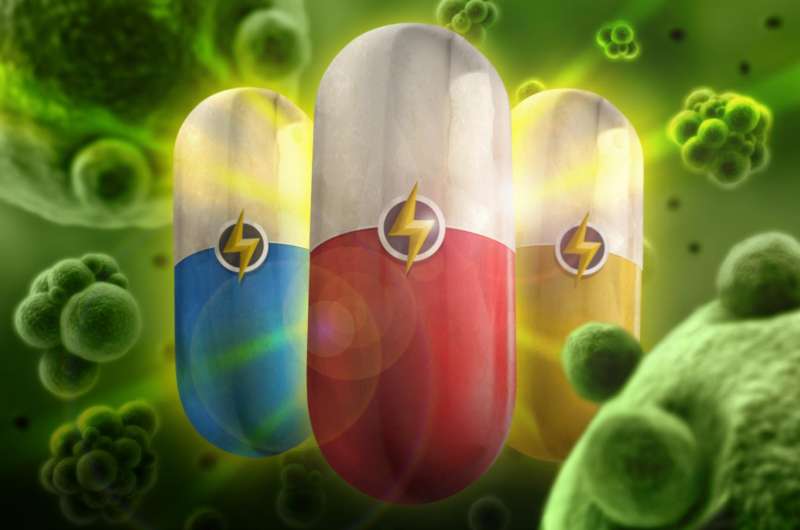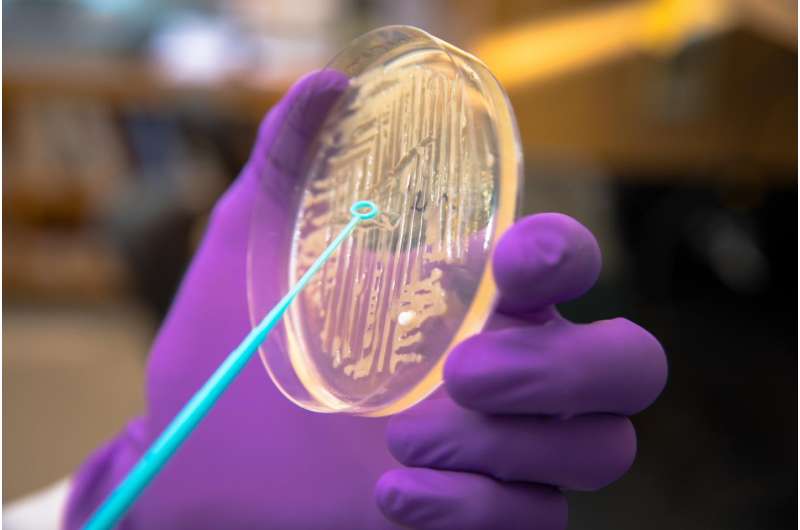Once invincible superbug squashed by 'superteam' of antibiotics

The golden age of antibiotics may be drawing to a close. The recent discovery of E. coli carrying mcr-1 and ndm-5—genes that make the bacterium immune to last-resort antibiotics—has left clinicians without an effective means of treatment for the superbug.
But in a new study, University at Buffalo researchers have assembled a team of three antibiotics that, together, are capable of eradicating the deadly bacterium. The groundbreaking research was recently published in mBio, a journal for the American Society of Microbiology.
The researchers found that a novel combination of aztreonam, amikacin and polymyxin B—a last-resort antibiotic—was able to kill E. coli carrying mcr-1 and ndm-5 genes within 24 hours while also preventing regrowth. Traditional combinations of these antibiotics were unable to kill the E. coli and resulted in rapid resistance.
"The threat of gram-negative bacteria, including E. coli carrying mcr-1, is worrisome," says Zackery Bulman, PharmD, first author on the study, a graduate and former postdoctoral fellow at the UB School of Pharmacy and Pharmaceutical Sciences who is now an assistant professor at the University of Illinois at Chicago College of Pharmacy.
"We believe that the appearance of mcr-1 and ndm-5 in patients may be a harbinger for what is to come. The golden era of antibiotics isn't over yet, but we wanted to help clinicians prepare therapeutically for the occurrence of these strains."
Brian Tsuji, PharmD, principal investigator and associate professor in the School of Pharmacy and Pharmaceutical Sciences, continued: "That is why the mcr-1 and ndm-5 strains represent an urgent threat, because of the high-degree of resistance combined with the potential for rapid spread in the community setting. We had to work quickly and think outside of the box, beyond traditional antibiotic combinations."
"This is the first study to propose therapeutic solutions with three drugs against superbugs harboring mcr-1 and ndm-5. The results will help prepare clinicians for future occurrences of these pathogens."

Fewer than two dozen cases of E. coli carrying mcr-1 have been reported in the U.S. However, with additional cases reported worldwide, the bacteria's immunity to available antibiotics has left the medical community vulnerable to a massive outbreak of infections.
The rapid increase in antibiotic-resistant bacteria has resurrected the importance of polymyxins, a class of antibiotics that are effective but employed as a last resort because of the damage they can cause to the kidneys.
To avoid prescribing high dosages of polymyxins and to make up for the antibiotic's weaknesses, the researchers decided to turn to new dosing strategies and multiple antibiotic combinations.
After conducting studies on dozens of combinations of more than 15 antibiotics paired with polymyxin B, the researchers discovered two effective treatments. Combinations of polymyxin B with either aztreonam or amikacin resulted in undetectable bacterial counts after 24 hours.
The E. coli, however, was able to regrow to initial levels after 96 hours and a subpopulation of amikacin-resistant strains arose after 10 days when exposed to the combination of polymyxin B and amikacin. Polymyxin B and aztreonam pushed the E. coli into a persistent but nonreplicating state. Only the triple combination eliminated the E. coli strain and prevented regrowth.
"We knew that polymyxins alone couldn't work. Only the three drugs combined were able to work synergistically to suppress and kill the bacteria," says Bulman. "We overcame the bacteria by pushing it as far as possible with an agent that it was resistant to while simultaneously administering two other antibiotics."
The promising finding may provide a viable treatment against mcr-1 and ndm-5 strains.
The research was funded through a $4.4 million National Institutes of Health (NIH) grant awarded to Tsuji to develop new dosing regimens for polymyxins.

















